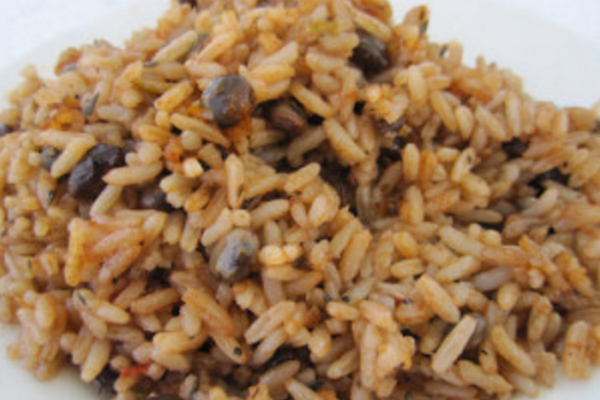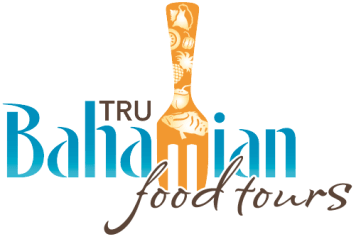Tru Bahamian Must Eats: Peas & Rice

A side order of peas & rice (or rather, Peas n’ Rice) is as part of any bona fide Bahamian meal as palm trees are to our beautiful island landscape. Served alongside fish, meat or chicken, this beloved staple food is thoroughly enjoyed by Bahamian locals for lunch or dinner or both. In fact, it’s practically required in order to adequately complete a proper meal in these parts:) Along with a handful of other favourites such as: Johnny Cake & Conch Salad, this storied local delicacy is mandatory to try during your time in The Bahamas and it’s certainly worthy of “Tru Bahamian Must Eat” status!
What is Peas n’ Rice?

While unfailingly tasty, Bahamian Peas n’ Rice contains a pretty basic ingredient list: deep brown pigeon peas, white long grain rice (most local chefs use the Mahatma brand), seasoned with tomatoes, onions, fresh thyme, tomato paste and (usually) salted pork or bacon. Depending on the dining audience, goat pepper can also be included to give the dish some additional kick. Essentially all of these ingredients work in tandem to flavour and “brown” the rice, which results in a hearty and well seasoned pot. In general, Bahamian Peas n’ Rice is the signature side dish served alongside a wide variety of other mealtime components such as: steamed or fried fish/chicken, baked macaroni and cheese, potato salad, cole slaw, fried plantain and maybe tossed salad too.
Origins Of The Dish
The historical origins of this dish date way back to the late nineteenth century when subsistence farming was a necessity in the Family Islands (aka- all islands in The Bahamas apart from New Providence and the capital of Nassau) where most citizens engaged in outdoor labor of some sort. Hardy pigeon pea plants and corn (harvested and ground into cornmeal grits) were both reliable food staples that complemented each other well. On any given day in a Bahamian field, you would find tall stalks of corn (interspersed with vine plants like beans, okra, and tomatoes), and large pigeon pea plants on the exterior of the field. Since the harvesting of corn and pigeon peas generally followed each other after the rainy season, it was a common practice to prepare a nutritious meal with cornmeal grits (still used commonly in Bahamian culture today) and pigeon peas. As an antecedent to Peas n’ Rice, the combination of grits and pigeon peas with any meat or fish that was available at the time was an old Bahamian staple that has remained a key components of a local feast.
Since rice is not cultivated in The Bahamas, the now universal dish of Bahamian Peas n’ Rice only grew to be commonplace when rice and other processed foods entered the local food supply through food imports from the American South in the early twentieth century.
Peas n’ Grits (and later Peas n’ Rice) was originally enjoyed as a one-pot meal complete with meat, veggies, and a starch all in one. This dish allowed earlier islanders to survive off of foods that farming in Bahamian soil could provide and also offered a hearty meal while serving as an excellent source of nutrition for days spent toiling in fields. Over time however, Peas n’ Rice has since transitioned into playing more of a side dish role on the modern day Bahamian plate.
Bahamian “Peas n’ Rice” vs. “Rice and Peas”
We know what you’re thinking: this rice dish is probably the same as any other you’d come across in this region of the world. But…not exactly. It is true that the vast majority of Caribbean countries enjoy a common rice dish as well, the most popular and well known likely being the famous “rice and peas” dish served in Jamaica. But, while the use of the peas and rice in the naming of dishes elsewhere suggests similarities, in fact there are some important distinctions among these rice staples with respect to taste, texture and appearance.
Primarily:
- Bahamian Peas n’ Rice is made (as stated above) with pigeon peas. In contrast, Jamaican rice and peas is made with beans or any available legume, most commonly the kidney bean. It tends to more closely resemble the rice dishes of our Latin American neighbors such as Costa Rica’s “gallo pinto” (with red or black beans) or even the “hoppin’ John” (with black-eyed peas) found throughout the southern US.
- Bahamian Peas n’ Rice tends to be much darker looking in complexion than Jamaican Rice and Peas due to the “browned” sauce and use of tomato products.
- Bahamian Peas n’ Rice is a heavier dish than its Caribbean counterparts as a result of the salted pork component and chunky vegetables. In contrast, you’ll find that dishes like Jamaican Rice and Peas rely on scallions and coconut milk for the flavor so the dish is a little sweeter and lighter in texture.
Where To Eat It
Now that we’ve covered all the basics, you need to know where and how to get your fork into this signature side dish. As we already mentioned, you’d be hard pressed to find any Bahamian establishment that doesn’t serve Bahamian Peas n’ Rice as one of its side dishes on the menu. We recommend your choice of any “down-home” Bahamian restaurant including Nesbitts or the myriad of eateries located at Arawak Cay like Drifters, Oh Andros or The Anchorage. Alternatively, if you’re in the mood for a more upscale dining setting, the Poop Deck locations or the newly remodelled Traveller’s Rest know how to prepare this dish right too. On our own Bites of Nassau Walking Food Tasting & Cultural Walking Tour, we of course feature this Bahamian delicacy deliciously during our visit to Bahamian Cookin’ restaurant in Downtown Nassau (open for lunch only).
How To Prepare It At Home
Ingredients:
- 1 small onion
- 1 small sweet pepper
- 1 tbsp cooking oil
- 2 strips cooked bacon
- 2 tbsp tomato paste
- Three or four sprigs of fresh thyme
- Salt & red pepper to taste
- 1 tsp browning (optional)
- 1 chopped fresh tomato (optional)
- 1 large can of regular pigeon peas or pigeon peas in coconut milk
- 2 cups uncooked long grain white rice
- 3 cups water
Directions:
- Dice onion and sweet pepper
- In a hard-bottom pot heat up oil and fry onion, sweet pepper, and bacon along with the thyme
- Stir in tomato paste, add salt and pepper to taste (and optional browning and chopped tomato)
- Add the pigeon peas and stir well, add water and bring to a boil. Season to taste.
- Add the rice until it is about an inch and a half below the water line
- Stir well, lower the stove to medium with pot uncovered
- While the pot is simmering, stir at regular intervals
- When the rice has absorbed most of the water, turn the stove to low heat and cover the pot
- Leave to steam until fully cooked
- Enjoy with meat or fish
Recipe adapted from Cooking With Sugar
NOTE: If you want to save time in the kitchen, most local grocery stores even sell pre-cooked Bahamian Peas n’ Rice in a can! Just look for the Bahamian-owned Sawyer’s brand in the canned good section.
